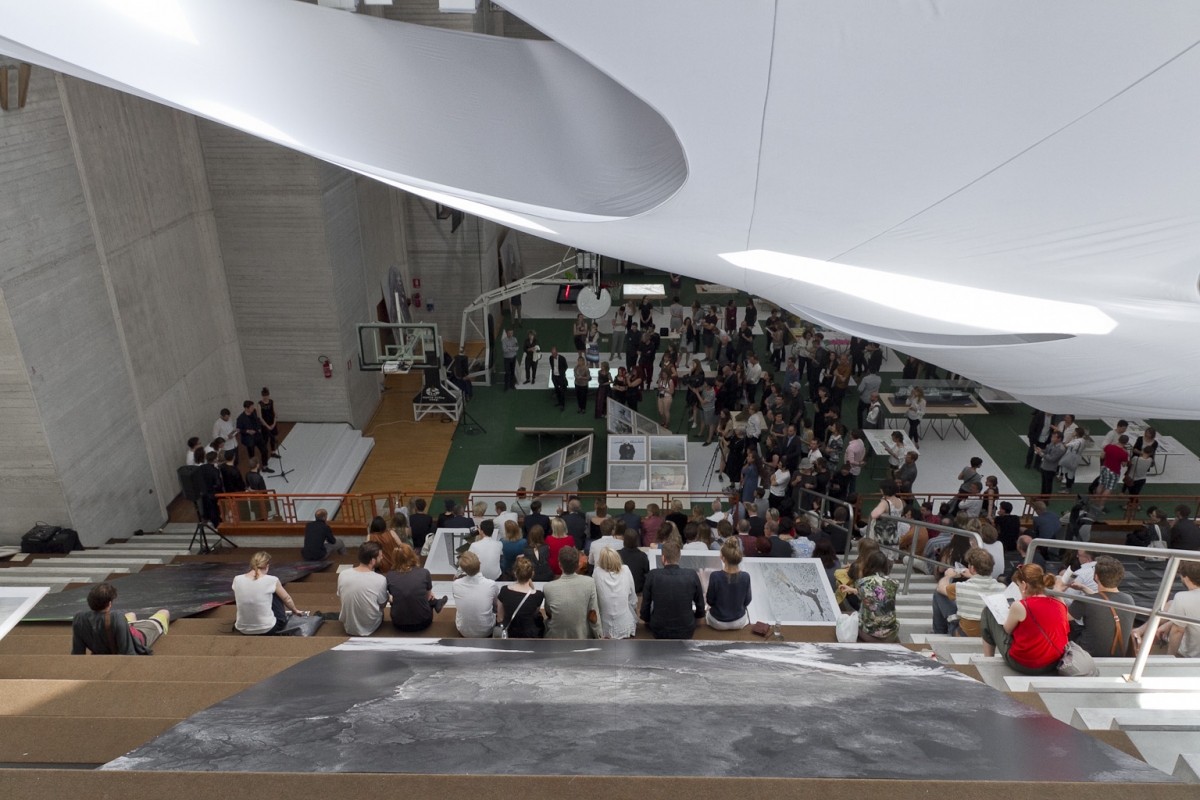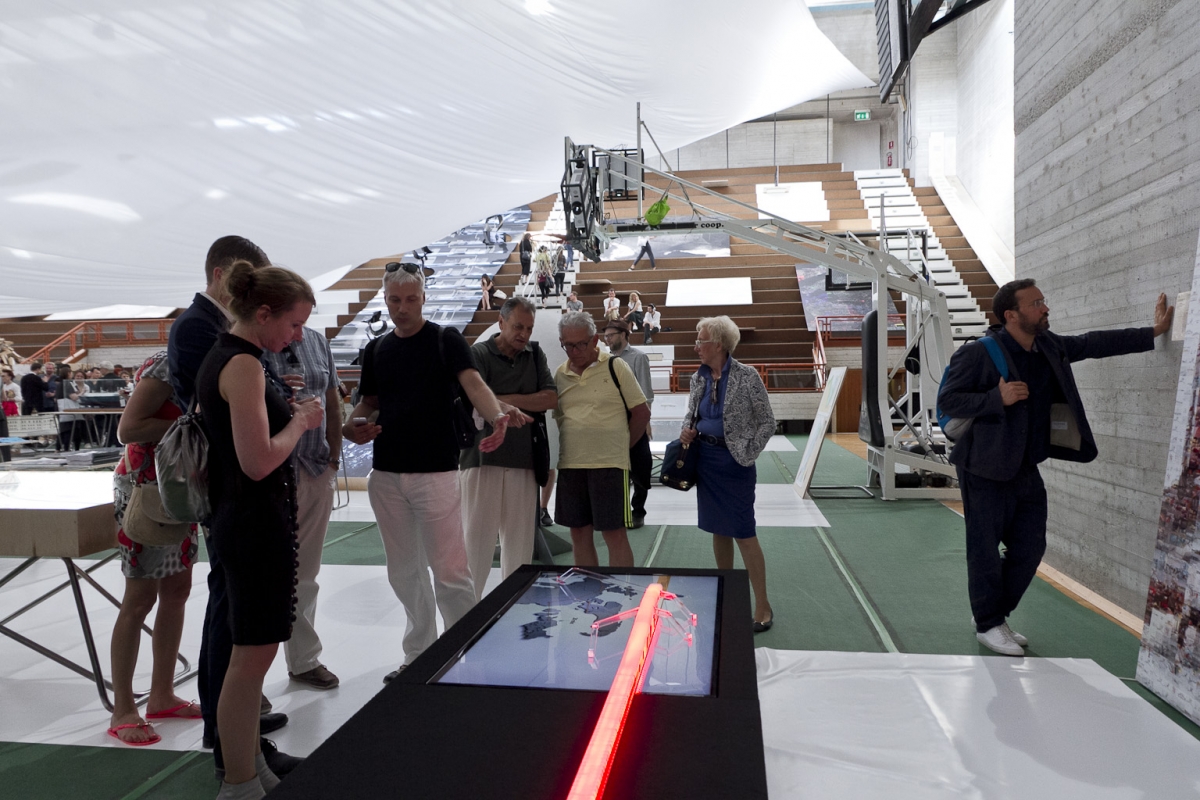
Photography: David Grandorge
On the 28th of May, the Baltic Pavilion, representing Estonia, Latvia and Lithuania at the 15th International Architecture Exhibition, la Biennale di Venezia 2016, opened its doors in Palasport Arsenale. This project was made possible after its proposal, to represent three states in one joint exhibition, won three separate national competitions.
The team representing the three countries collectively is made up of nine architects, designers and theoreticians: Kārlis Bērziņš, Jurga Daubaraitė, Petras Išora, Ona Lozuraitytė, Niklāvs Paegle, Dagnija Smilga, Johan Tali, Laila Zariņa and Jonas Žukauskas. Together, they are seeking to unravel the conventions and instruments operated by a wide range of spatial practices, industries, and infrastructures that are actively transforming the built space of the three Baltic States and wider region(s). The pavilion includes more than a hundred exhibits, each belonging to different fields ranging from architecture and engineering, to geology and art. A full list of the authors and contributors can be seen online at: http://balticpavilion.eu/. A week prior to the opening, Eglė Juocevičiūtė asked three members of the curatorial team to offer some insights on the conceptual framework which was used to develop their project.
Is there anything that is not part of what you see as infrastructure and as the material for the Baltic pavilion?
Johan Tali: What we see as “material” for the pavilion is, on one hand, a highly subjective take on the region and should not be categorised as “infrastructure or not infrastructure”, but more driven from a huge group of investigators, or invigilators, (represented by nine curators) developing strategic agendas or insights to share. This is so that we can categorise the material in the show rather as elements, materialities and projects describing the forces currently transforming the region. The exhibition is thus not about a common denominator of things or definitions, and the realisation that everything can be solved with the same formula. It is much more about recognising a common set of problems and opportunities apparent in the shared space. It is also about understanding this as a task for the future of architecture, accepting that solutions don’t just come as answers to “choose from between A, B or C”…
Jonas Žukauskas: Infrastructure enables the flow and distribution of resources. Infrastructure space is dependent on resources and is shaped by their availability. The spatial organisation could be compared to software. It is a functional program responding to, and communicating with, many inputs and outputs at the same time but differently to digital scripts the spatial structures which are inert. They are inscriptions into material assemblies: roads, railways, pipelines and such. Your question suggests the understanding of infrastructure governs not only material structures, but also structures enabling knowledge production, for example. So indeed, in this way, it would be difficult to say what is not, seen as material for the Baltic Pavilion. However, it is important to stress that we are looking into how things connect and relate to, or overlay, each other. The Baltic Pavilion project is not only an attempt to be inside one definition of what infrastructure is, but rather to be inside many definitions tracing different kinds of ways infrastructure relates (to) resources. There are many modes of this relationship shown in the Baltic Pavilion exhibition.
Dagnija Smilga: When reflecting upon a cultural infrastructure, for example, the Latvian National Library is not just a structure built behind the word “infrastructure”. By unfolding this issue and exploring it in more depth, we could look at the digital network, for instance, where all the Latvian libraries are tied together in one online catalogue that is supposed to change the use of libraries in small villages across the country, as well as the behaviour of its users. This network not only demands knowledge of certain software, but also optical cables installed, usually following the road networks. With this, I am trying to portray a more complex infrastructural issue consisting of the library building as an architectural icon, digital software as the OS, and cables as connections laid down beneath the soil.
Thinking back now to the roots of our project, as curators, we always wanted to establish an agency that could operate in various modes, but at the same time could be an archive of ideas linked to the region in space and time, in order to indicate upcoming questions for the future. What this project has allowed us to have so far, is incredible access to protected data, information and knowledge previously locked. Perhaps the Baltic Pavilion has the potential to become a framework for processes that will be important for future built environments. It might be a kind of infrastructure for thinking.

Photography: Ingel Vaikla
How much is the socio-geographic, geological and/or political history of the region important in itself for the project? And how much is it a ground for speculating on the future of joint infrastructural possibilities?
D.S: There is a pattern in the Baltics of reusing industrial space for cultural infrastructure. In a way, these structures, historically built for production purposes, start to function as a hull for cultural activities. Along with that comes certain recognisable aesthetics, of course. As the infrastructure demands one of the highest investments, the temporary reuse of partially existing structures remains a logical solution.
During the Soviet period, where infrastructure was more a sign of power and prosperity, a lot of buildings were built that are quite difficult to maintain now within a democratic society. The layered priorities of European projects are much more fragmented and dispersed. Big tasks still remain about how to sustain, reuse and reinvent less appreciated Inter-War and Post-War infrastructures in the Baltics that often come with their complications that demand new approaches and solutions. As this heritage is common for all three Baltic countries, it made sense that, on these fronts, we should share our ideas and even operate more commonly.
After visiting the events connected to the pavilion – the lectures and discussions on mining phosphorite in Estonia and the closing and dismantling of Ignalina Nuclear Power Plant in Lithuania – it seems that the relationship between the processes of industrialisation and the phenomenon or feeling of nationality should have occurred several times in the research process. What conclusions can you make on how the relationship works or what discussions do you predict await us?
J.T.: Public space is key! Governmentality is tied strongly to the democratic and non-democratic processes that it feeds on. The public, or the nation, is becoming more and more resourceful for decision making. For example, the rise of populist politics is shaping the public sphere starting with new walls being built to keep immigrants out or hollowing the bottom geological layers for wealth. We have come across moments where spatial qualities can become the foundation and platform for public debate. In this way, we have been able to help tilt the discussions in one direction or another regarding these aesthetic and spatial environments.
D.S.: Remembering the debate on phosphorite mining in Tallinn in February 2016, it is clear that the discussions which took place in the 80s were very different from those today. Back then, the historical debate was very much driven by arguments of nationalism and mining as part of the Soviet agenda, whereas now, it unfolds among members of the ministry of economy, environmentalists and industrial companies running out of mining options for shale oil. Significantly, their inability to develop solid arguments for or against mining due to the lack of information and in-depth research on both fronts was very evident. In the end, because there was not enough knowledge, they could not make a decision. The upcoming discussions we should be facing range from the opinions of our societies to the knowledge of experts, from material manifestation of resource extraction in fragile landscapes, to the policies and development strategies of the region.
In the specific case of mining phosphorite, a critical question is not just how to extract resources and produce money quickly, but rather how to add value to the resource on site. For this, we need to develop ways to grow knowledge and crafts around this issue. What if the educational policy is linked with the mining laws and decisions? Who would be able to foster this exchange? Can we invest in an educational facility hosting experts in geography, geology and anthropology etc. located in the Special Economic Zone (SEZ) of phosphorite mining? Would that bring diversification of materials and knowledge flows in the region and change the built environment?

Photography: Ingel Vaikla
What are the categories of the exhibits (documentary photos, artistic photography, scientific drawings, schemes, objects, models etc.)? Is the overall experience of the pavilion somehow modelled according to the purpose or meaning of the exhibits (whether there’s always a schematic, abstract, functional representation going together with a pictorial representation of the object or issue)?
J.T: For a long time we were flirting around with the idea of a collection or a visual atlas of objects that could not be pinned down to one category, but rather, to seek up a spatiality that would allow that collection to be determined. Following this — one spatiality can be determined by its soils, by its cultural production, by its laws and standards etc. There is definitely a strong connection between those objects and modes of exhibiting ideas and different spatialities.
J.Ž: Exactly. The project unfolds as a gradient between a range of modes of sensing. There are two completely different purposes for images or representations at both ends of this gradient, and we are placing them in proximity and relation: first, operative images such as diagrams, documentation, or samples that are integral parts of operations used to run infrastructures and businesses, to distribute flows of materials; and secondly, the subjective projections or reflections taking authentic forms.
D.S: We set a challenge to discuss the issues through three dimensional objects. The spatial dimensions on these highly complex topics were important to us. The arrangements of the artefacts in space had certain links among each other. And this created a field of visual and intellectual density, a “horizon of artefacts”. And then all of that started to interact unexpectedly and intentionally.
When comparing the fragmented connections in the socio-cultural and political level of the three Baltic countries, are there any parallels with connections in their infrastructure?
J.Ž: It feels that the search for national identity mobilises the public along the fragmented definitions such as “nation state — this mechanism is an ancient machinery of myth production — a contained place to channel the energy we all have. At the same time, infrastructure space always was and continues to be governing the flows that are not defined by this fragmentation.

Photography: Ingel Vaikla
Are we much more “connected” than we realise?
J.Ž: The focus of the Baltic Pavilion comes at a moment when infrastructure spaces are now in plain sight and have become a public concern due to geopolitical tensions. They were in place during our quest for independence, but events unfolding in the last couple of years intensified everyone’s attention causing them to trace the forces governing the distribution of resources along the infrastructures built in times of Soviet industrialisation. And it marks the moment of realisation that we have the means not only to diversify the maintenance supply flows, but to completely reprogram the spaces we inhabit as we realise our everyday practices in relation to infrastructure are keeping us inert.
D.S: The meaning of an infrastructure project materialises very strongly not only in built space, but also in a mental body of the society. A new pipeline or a transportation link becomes just as much a physical intervention as a mental connector thanks to the processes it demands to make it. Infrastructure becomes very visible and tangible when it fails. It becomes a shared experience where people join in common actions.
Now the Baltic States are approaching one of the EU priority infrastructure projects, “Rail Baltica”, a train line that runs through the Baltic countries linking them together. The ky to the debate is in understaning and strategically planning a well functioning transport system and its infrastructure. We cannot fall into the trap of fighting the project because of bureaucratic difficulties in cross-border relations. A project like this should go beyond these boundaries and limitations, serving the accessibility and vitality of the region by helping to foster exchange within it. We should envision a train line stretching through the Baltic landscape. What do we see? What is our experience getting on a train in Rail Baltica station in Riga airport, and getting off in Tallinn?
When Palasport Arsenale was used for oO pavilion of Lithuania and Cyprus at the 55th International Art Exhibition, la Biennale di Venezia 2013, the activities happening in the institution (a sports centre for the locals), its “communal character” was included in the conceptual framework of the project. What is the situation this time? Will the pavilion become a moving exhibition in September because of the schedule of Palasport?
J.T: It is true that this exhibition will close sooner or later in the space we have rented. What is important is that the momentum we gathered will travel back and forth and cause a range of various reactions and counter actions. To be honest, it would be really difficult to describe this project as a guideline to architects saying that this is the way things should be done, or to say that what we have started here needs to be seen by the world. But I wish every project was this exciting to everyone.
J.Ž: The Palasport is a pure example of Brutalist architecture. The building is named after Giobatta Gianquinto, Venetian, member of the Italian Communist Party and mayor of Venice from 1946 to 1951. Its Brutalist, cast in-situ bare concrete form carried the ethical program at the time it was built in 1977. Architecture then, was concerned with communicating the development of building technology with social purposes. Palasport, in my view, exemplifies the kind of statements or architectural brief issued at that time: to formulate and provide spaces for the society that were previously unavailable. In the context of the historic city, the “Palace of Sports” had a new purpose that it still carries. It is used intensively for sporting activities and communal events. The process of using the space is complex and intertwined not only with its calendar, but also with its general function for celebrating activities by groups of people. Perhaps it is not an accident that the meaning of its ethical architectural form enhances the Baltic Pavilion installation enabling it to continue adapting and changing form through time.
























